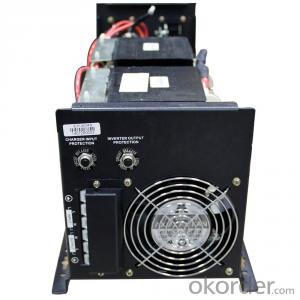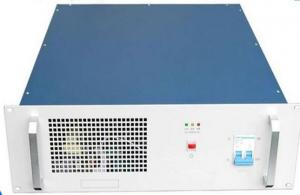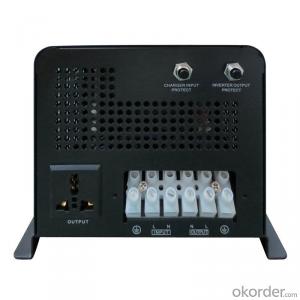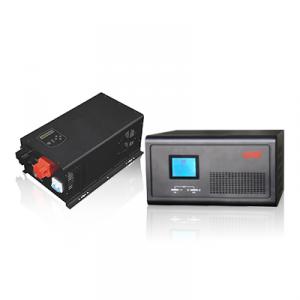Solar Inverter 1kva Pure Sine Wave Inverter Low Frequency EP3000 Series 8kw-12kw
- Loading Port:
- China main port
- Payment Terms:
- TT OR LC
- Min Order Qty:
- 10 pc
- Supply Capability:
- 1000 pc/month
OKorder Service Pledge
OKorder Financial Service
You Might Also Like
Features:
. Smart Remote Control (RMT)
. Battery Temperature Sensor (BTS)
. Automatic Generator Starting (AGS)
. Support Solar Panel with MPPT Function
. Designed to Operate under Harsh Environment
. DC Start & Automatic Self-Diagnostic Function
. Compatible with Both Linear & Non-Linear Load
. Easy to Install & Easy to Operate & Easy to Solve
| Model | 8.0KW | 10.0KW | 12.0KW | |
| Inverter Output | Continuous Output Power | 8.0KW | 10.0KW | 12.0KW |
| Surge Rating(20ms) | 24.0KW | 30.0KW | 36.0KW | |
| Output Waveform | Pure Sine wave/Same as input(Bypass Mode) | |||
| Nominal Efficiency | >88%(Peak) | |||
| Line Mode Efficiency | >95% | |||
| Power Factor | 0.9-1.0 | |||
| Nominal Output Voltage rms | 100-110-120Vac / 220-230-240Vac | |||
| Output Voltage Regulation | ±10% RMS | |||
| Output Frequency | 50Hz ± 0.3Hz/60Hz ± 0.3Hz | |||
| Short Circuit Protection | Yes( 1sec after fault ) | |||
| Typical transfer Time | 10ms(Max) | |||
| THD | < 10% | |||
| DC Input | Nominal Input Voltage | 12.0Vdc | ||
| ( *2 for 24Vdc, *4 for 48Vdc) | ||||
| Minimum Start Voltage | 10.0Vdc | |||
| Low Battery Alarm | 10.5Vdc / 11.0Vdc | |||
| Low Battery Trip | 10.0Vdc / 10.5Vdc | |||
| High Voltage Alarm | 16.0Vdc | |||
| Low Battery voltage recover | 15.5Vdc | |||
| Idle Consumption-Search Mode | < 25 W when Power Saver On | |||
| Charger | Output Voltage | Depends on battery type | ||
| Charger Breaker Rating | 40A | |||
| Max Charge Power Rate | 1/3 Rating Power | |||
| Battery Initial Voltage for Start Up | 10-15.7V for 12V( *2 for 24V, *4 for 48V) | |||
| Over Charge Protection Shutdown | 15.7V for 12V (*2 for 24V, *4 for 48V) | |||
| Remote Control | Yes(Optional) | |||
| Bypass & Protection | Input Voltage Waveform | Sine wave (Grid or Generator) | ||
| Nominal Voltage | 230Vac | |||
| Max Input AC Voltage | 150VAC For 120Vac LV Mode;300VAC For 230Vac HV Mode; | |||
| Nominal Input Frequency | 50Hz or 60Hz (Auto detect) | |||
| Low Freq Trip | 47±0.3Hz for 50Hz, 57±0.3Hz for 60Hz | |||
| High Freq Trip | 55±0.3Hz for 50Hz, 65±0.3Hz for 60Hz | |||
| Overload protection(SMPS load) | Circuit breaker | |||
| Output Short circuit protection | Circuit breaker | |||
| Bypass breaker rating | 50A | 63A | 63A | |
| Transfer switch rating | 80amp for UL | |||
| Bypass without battery connected | Yes (Optional) | |||
| Max bypass current | 80amp | |||
| Solar Charger (Optional) | Rated Voltage | 12Vdc / 24Vdc / 48Vdc | ||
| Solar Input Voltage Range | 15-30Vdc / 30-55Vdc / 55-100Vdc | |||
| Rated Charge Current | 40 ~ 60A | |||
| Rated Output Current | 15A | |||
| Self Consumption | < 10mA | |||
| Bulk Charge(Default) | *2 for 24Vdc, *4 for 48Vdc | |||
| Floating Charge(Default) | ||||
| Equalization Charge(Default) | ||||
| Over Charge Disconnection | ||||
| Over Charge Recovery | ||||
| Over Discharge Disconnection | ||||
| Over Discharge Reconnection | ||||
| Temperature Compensation | ||||
| Ambient Temperature | 0 ~ 40°C(Full load) 40 ~ 60°C(Derating) | |||
| Mechanical Specifications | Mounting | Wall Mount | ||
| Inverter Dimensions(L*W*H) | 588*415*200mm | |||
| Inverter Weight(Solar Chg)KG | 60+2.5 | 66+2.5 | 70+2.5 | |
| Shipping Dimensions(L*W*H) | 750*520*310mm | |||
| Shipping Weight(Solar Chg)KG | 62+2.5 | 68+2.5 | 72+2.5 | |
| Display | Status LEDs / Status LEDs+LCD | |||
| Standard Warranty | 1 Years (Optional) | |||
Warranty
provides a 1~3 year limited warranty (“Warranty”) against defects in materials and workmanship for its Uninterruptible power supply, Power inverter/chargers, Solar charge controllers, Battery Products (“Product”).
The term of this Warranty begins on the Product(s) initial purchase date, or the date of receipt of the Product(s) by the end user, whichever is later. This must be indicated on the invoice, bill of sale, and/or warranty registration card submitted to MUST-Solar. This Warranty applies to the original MUST-Solar Product purchaser, and is transferable only if the Product remains installed in the original use location.
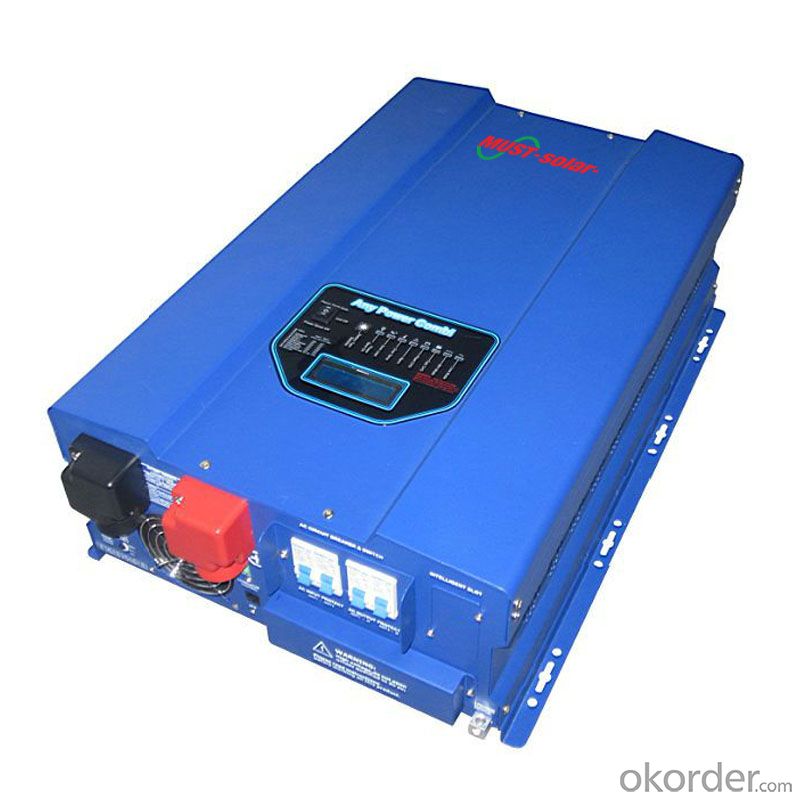

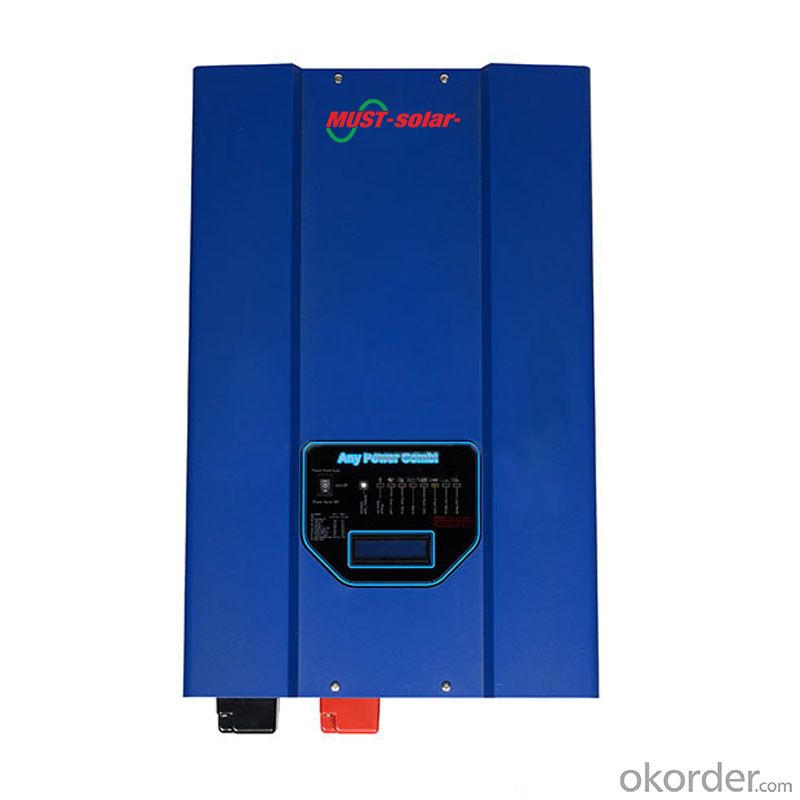
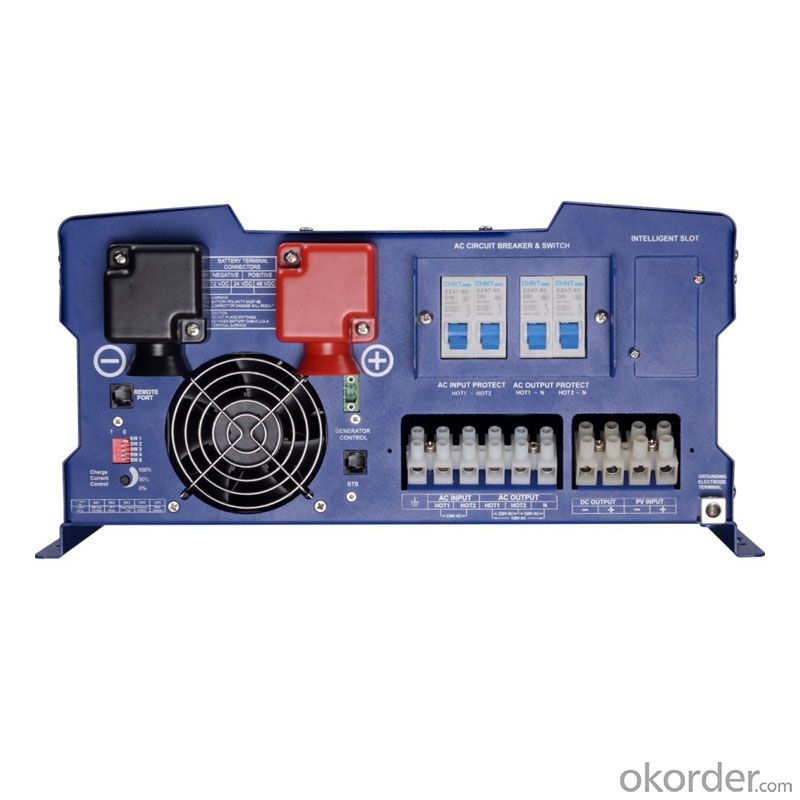
FAQ
1. How do I decide which system is right for me ?
For protection from long outages, include a generator or solar panels in your Must solar system. Shorter outages can be handled by a battery-only system.
2. Where my system will be installed ?
Must solar systems are usually wall-mounted near a home's main electrical (circuit breaker) panel.
3. How do I install my system ?
A must solar backup inverter is connected to a home electric system , we will supply detailed installation manual and videos for our customers .
- Q: Can a solar inverter be used in standalone power systems?
- Yes, a solar inverter can be used in standalone power systems. Standalone power systems, also known as off-grid systems, are not connected to the main electricity grid and rely on alternative energy sources like solar panels. A solar inverter converts the direct current (DC) generated by the solar panels into usable alternating current (AC) electricity, which can power various electrical devices in standalone power systems.
- Q: What is the role of a power management system in a solar inverter?
- The role of a power management system in a solar inverter is to optimize the generation, distribution, and usage of solar power. It ensures efficient energy conversion, monitors the solar panel performance, manages the flow of electricity to and from the grid, and maximizes the overall system efficiency. Additionally, it may include features such as power factor correction, voltage regulation, and protection mechanisms to enhance the reliability and safety of the solar inverter.
- Q: What is the operating temperature range of a solar inverter?
- The operating temperature range of a solar inverter typically varies, but it is commonly between -20°C to 60°C.
- Q: How do you calculate the maximum power point tracking efficiency for a solar inverter?
- To calculate the maximum power point tracking (MPPT) efficiency for a solar inverter, you need to compare the actual power output of the inverter with the maximum power point (MPP) of the solar panel. It can be calculated by dividing the actual power output by the MPP power and then multiplying the result by 100 to get the efficiency in percentage. The formula is: MPPT efficiency = (Actual Power Output / MPP Power) * 100.
- Q: Can a solar inverter be used with a solar-powered desalination system?
- Yes, a solar inverter can be used with a solar-powered desalination system. A solar inverter is responsible for converting the direct current (DC) electricity produced by solar panels into alternating current (AC) electricity that can be used to power electrical devices. In the case of a solar-powered desalination system, the solar inverter would be essential to convert the DC electricity generated by the solar panels into AC electricity to power the desalination equipment and ensure the system functions properly.
- Q: How does a solar inverter prevent islanding?
- A solar inverter prevents islanding by constantly monitoring the electrical grid's voltage and frequency. If it detects a disruption or deviation from the standard parameters, it immediately shuts down or disconnects from the grid to prevent energy from being fed back into the grid during a power outage. This ensures the safety of utility workers who might be working on the grid and prevents any damage to the electrical system.
- Q: What is the role of voltage support in a solar inverter?
- The role of voltage support in a solar inverter is to maintain a stable and appropriate voltage level for the solar system. It ensures that the generated solar power is compatible with the electrical grid and devices connected to it, preventing any damage or malfunction. Additionally, voltage support helps optimize the efficiency and performance of the solar inverter, maximizing the power output from the solar panels.
- Q: Can a solar inverter be used in a mobile or portable solar power system?
- Yes, a solar inverter can be used in a mobile or portable solar power system. Solar inverters are designed to convert the DC (direct current) electricity generated by solar panels into AC (alternating current) electricity that can be used to power various devices. In a mobile or portable solar power system, the solar inverter plays a crucial role in converting the energy collected by the solar panels into a usable form for powering appliances or charging batteries.
- Q: What is the role of a voltage regulator in a solar inverter?
- The role of a voltage regulator in a solar inverter is to maintain a consistent and stable output voltage despite fluctuations in the input voltage from the solar panels. It ensures that the electricity generated by the solar panels is converted and delivered to the connected devices or grid at the required voltage level, preventing any damage to the devices and optimizing the overall efficiency of the solar power system.
- Q: Are all solar inverters compatible with all solar panels?
- No, not all solar inverters are compatible with all solar panels. The compatibility between solar inverters and panels depends on various factors such as the voltage, current, and type of panels being used, as well as the specifications and requirements of the specific inverter model. It is important to ensure that the inverter is compatible with the specific type and configuration of solar panels being installed to ensure optimal performance and efficiency.
Send your message to us
Solar Inverter 1kva Pure Sine Wave Inverter Low Frequency EP3000 Series 8kw-12kw
- Loading Port:
- China main port
- Payment Terms:
- TT OR LC
- Min Order Qty:
- 10 pc
- Supply Capability:
- 1000 pc/month
OKorder Service Pledge
OKorder Financial Service
Similar products
Hot products
Hot Searches
Related keywords


















